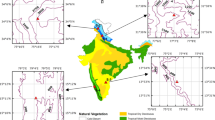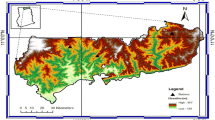Abstract
Vegetation dynamics are sensitive to climatic warming and are affected by individual or combined climatic factors at different temporal scales with different intensities. Previous studies have unraveled the relationships between vegetation dynamics and individual climatic factors; however, it is unclear whether the effects of single or combined climatic factors on vegetation dynamics are dominant for different temporal scales, vegetation types, and climatic regions. The objective of this study was to explore scale-specific univariate and multivariate controls on vegetation over the period 1982–2015 using bivariate wavelet coherence (BWC), multivariate wavelet coherence (MWC), and multidimensional empirical mode decomposition (MEMD). The results indicated that significant vegetation dynamics were located mainly at scales of 1, 0.5, and 0.3 years. Vegetation variations were divided into seasonal (≤ 1 year), short-term (1–4 years), medium-term (4–8 years), and long-term (> 8 years) scales. The combined explanatory powers of seven climatic factors on the vegetation were greater at the short-term and long-term scales, whereas individual climatic factors, such as precipitation or temperature, might affect vegetation dynamics in some climatic regions at the seasonal and medium-term scales. The combined effect of climatic factors in the grassland of the Tibetan Plateau (TP) and the temperate grassland of Inner Mongolia (TGIM) were the greatest, which were 65.06% and 59.53%, respectively. The explanatory powers of climate on crop dynamics in both temperate humid and subhumid Northeast China and the TP were around 47%, whereas the controls of climate on crops in both the TGIM and the temperate and warm-temperate desert of Northwest China were around 39%. Cropland farming practices could alleviate the spatial variation of the relationships between climate and vegetation while enhancing the temporal difference of their relationships. Additionally, the dominant influencing factor among different regions varied greatly at the medium-term scale. Collectively, the results might provide an alternative perspective for understanding vegetation evolution in response to climatic changes in China.





Similar content being viewed by others
Data availability
The climate data are available from the Climatic Data Center, National Meteorological Information Center (https://data.cma.cn/). The NDVI was derived from Global Inventory Modeling and Mapping Studies (GIMMS) (https://ecocast.arc.nasa.gov/data/pub/gimms/) and obtained from Advanced Very High Resolution Radiometer (AVHRR) sensors on board National Oceanic and Atmospheric Administration (NOAA) satellites. Annual Moderate Resolution Imaging Spectroradiometer (MODIS) Land Cover Type (MCD12Q1) data layers for China from 2001 to 2015 were obtained from the Level-1 and Atmosphere Archive and Distribution System (LAADS) (https://ladsweb.modaps.eosdis.nasa.gov/).
Code availability
Software: MATLAB, R.
References
Bai L, Yang L, Song B, Liu N (2020) A new approach to develop a climate classification for building energy efficiency addressing Chinese climate characteristics. Energy 195:116982
Centeno LN et al (2020) Dominant control of macroporosity on saturated soil hydraulic conductivity at multiple scales and locations revealed by wavelet analyses. J Soil Sci Plant Nutr 20:1686–1702
Chuai X et al (2020) Vegetation and climate zones based carbon use efficiency variation and the main determinants analysis in China. Ecol Indic 111:105967
Cui L et al (2019) Spatiotemporal extremes of temperature and precipitation during 1960–2015 in the Yangtze River Basin (China) and impacts on vegetation dynamics. Theoret Appl Climatol 136:675–692
Ding Y, Li Z, Peng S (2020) Global analysis of time-lag and -accumulation effects of climate on vegetation growth. Int J Appl Earth Observ Geoinform 92:102179
Gao Q, Yu M, Xu H (2020) Directional climate trend, intensified intraannual variability, and changes in land cover drive the dynamics of vegetation greenness in peri-urban China during 2001–2015. J Geophys Res Biogeosci 125:e2019JG005336
Gardiner B, Berry P, Moulia B (2016) Review: Wind impacts on plant growth, mechanics and damage. Plant Sci 245:94–118
Grinsted A, Moore JC, Jevrejeva S (2004) Application of the cross wavelet transform and wavelet coherence to geophysical time series. Nonlinear Process Geophys 11:561–566
Gu X et al (2020) Identification and scaling behavior assessment of the dominant hydrological factors of nitrate concentrations in streamflow. J Hydrol Eng 25:06020002
He Y, Guo X, Dixon P, Wilmshurst JF (2012) NDVI variation and its relation to climate in Canadian ecozones. Can Geogr 56:492–507
Hou W, Jiangbo G, Shaohong W, Erfu D (2015) Interannual variations in growing-season NDVI and its correlation with climate variables in the southwestern Karst region of China. Remote Sensing 7:11105–11124
Hu W, Si BC (2016) Technical note: multiple wavelet coherence for untangling scale-specific and localized multivariate relationships in geosciences. Hydrol Earth Syst Sci Discuss 20:3183–3191
Hu W, Biswas A, Si B (2013) Application of multivariate empirical mode decomposition for revealing scale-and season-specific time stability of soil water storage. Catena 113:377–385
Hu W, Biswas A, Si B (2014) Application of multivariate empirical mode decomposition for revealing scale-and season-specific time stability of soil water storage. Catena 113:377–385
Hu W, Si BC, Biswas A, Chau HW (2017) Temporally stable patterns but seasonal dependent controls of soil water content: evidence from wavelet analyses. Hydrol Process 31:3697–3707
Jiang W, Wang L, Feng L, Zhang M, Yao R (2020) Drought characteristics and its impact on changes in surface vegetation from 1981 to 2015 in the Yangtze River Basin, China. Int J Climatol 40:3380–3397
Konrad W, Katul G, Roth-Nebelsick A (2021) Leaf temperature and its dependence on atmospheric CO2 and leaf size. Geol J 56:866–885
Li H et al (2020) Using the Budyko hypothesis for detecting and attributing changes in runoff to climate and vegetation change in the soft sandstone area of the middle Yellow River basin. China. Sci Total Environ 703:135588
Linscheid N et al (2020) Towards a global understanding of vegetation–climate dynamics at multiple time scales. Biogeosci Discuss 17:945–962
Liu Z, Menzel L (2016) Identifying long-term variations in vegetation and climatic variables and their scale-dependent relationships: a case study in Southwest Germany. Global Planet Chang 147:54–66
Liu H, Zhang M, Lin Z, Xu X (2018) Spatial heterogeneity of the relationship between vegetation dynamics and climate change and their driving forces at multiple time scales in Southwest China. Agric for Meteorol 256–257:10–21
Ning T et al (2019) Interaction of vegetation, climate and topography on evapotranspiration modelling at different time scales within the Budyko framework. Agric for Meteorol 275:59–68
Qi X, Jia J, Liu H, Lin Z (2019) Relative importance of climate change and human activities for vegetation changes on China’s silk road economic belt over multiple timescales. Catena 180:224–237
Qu S et al (2020) Distinguishing the impacts of climate change and anthropogenic factors on vegetation dynamics in the Yangtze River Basin. China. Ecol Indic 108:105724
Rathinasamy M, Agarwal A, Sivakumar B, Marwan N, Kurths J (2019) Wavelet analysis of precipitation extremes over India and teleconnections to climate indices. Stoch Env Res Risk Assess 33:2053–2069
Rehman N, Mandic DP (2010) Multivariate empirical mode decomposition. Proc Math Phys Eng Sci 466:1291–1302
Sen A, Chaudhury P (2019) On the co-movement of crude, gold prices and stock index in Indian market. arXiv preprint arXiv 1904: 05317
Song X et al (2020) Potential linkages of precipitation extremes in Beijing-Tianjin-Hebei region, China, with large-scale climate patterns using wavelet-based approaches. Theoret Appl Climatol 141:1251–1269
Sun Y, Yang Y, Zhang L, Wang Z (2015) The relative roles of climate variations and human activities in vegetation change in North China. Phys Chem Earth A B C 87–88:67–78
Sun C et al (2020) Tree-ring evidence of the impacts of climate change and agricultural cultivation on vegetation coverage in the upper reaches of the Weihe River, northwest China. Sci Total Environ 707:136160
Tong X et al (2016) Assessing future vegetation trends and restoration prospects in the Karst Regions of Southwest China. Remote Sens 8:357
Wu W et al (2013) Toward yield improvement of early-season rice: other options under double rice-cropping system in central China. Eur J Agron 45:75–86
Yan Z et al (2020) Assessment of the sustainability of different cropping systems under three irrigation strategies in the North China Plain under climate change. Agric Syst 178:102745
Yang SW, Zhang B (2014) Vegetation cover change and its response to climatic factors using SPOT NDVI in Hedong of Gansu Province. Chin J Ecol 32:455–461
Yao R, Cao J, Wang L, Zhang W, Wu X (2019) Urbanization effects on vegetation cover in major African cities during 2001–2017. Int J Appl Earth Obs Geoinf 75:44–53
Yuan M et al (2020) Vegetation green up under the influence of daily minimum temperature and urbanization in the Yellow River Basin. China. Ecol Indic 108:105760
Zewdie W, Csaplovics E, Inostroza L (2017) Monitoring ecosystem dynamics in northwestern Ethiopia using NDVI and climate variables to assess long term trends in dryland vegetation variability. Appl Geogr 79:167–178
Zhang ZS, Guo LJ, Liu TQ, Li CF, Cao CG (2015) Effects of tillage practices and straw returning methods on greenhouse gas emissions and net ecosystem economic budget in rice–wheat cropping systems in central China. Atmos Environ 122:636–644
Zhang Y, Zhu Z, Zhuo L, Zeng Z, Ciais P (2016) Seasonal and interannual changes in vegetation activity of tropical forests in Southeast Asia. Agric for Meteorol 224:1–10
Zhang H, Wu C, Hu BX (2019) Recent intensification of short-term concurrent hot and dry extremes over the Pearl River basin, China. Int J Climatol 39:4924–4937
Zhang W, Wang L, Xiang F, Qin W, Jiang W (2020) Vegetation dynamics and the relations with climate change at multiple time scales in the Yangtze River and Yellow River Basin. China. Ecol Indic 110:105892
Zhao S (1983) A new scheme for comprehensive physical regionalization in China. Acta Geogr Sin 50:1–10
Zhao W, Hu Z (2020) Contributions of climatic factors to inter-annual variability of vegetation index in northern China grasslands. J Clim 1:175–183
Zhao R et al (2018) Identifying localized and scale-specific multivariate controls of soil organic matter variations using multiple wavelet coherence. Sci Total Environ 643:548–558
Zhou X et al (2020) Legacy effect of spring phenology on vegetation growth in temperate China. Agric Forest Meteorol 281:107845
Zhu H, Hu W, Bi R, Peak D, Si B (2016) Scale- and location-specific relationships between soil available micronutrients and environmental factors in the Fen River basin on the Chinese Loess Plateau. CATENA 147:764–772
Zhu H et al (2019) Multi-scale spatial relationships between soil total nitrogen and influencing factors in a basin landscape based on multivariate empirical mode decomposition. J Arid Land 11:385–399
Funding
This work has been supported financially by the Natural Science Foundation of Shanxi Province (201801D221103) and the National Key Research and Development Program of China (2018YFE0109600).
Author information
Authors and Affiliations
Contributions
Hongfen Zhu: conceptualization, methodology, software handling, formal analysis, validation, and writing the manuscript. Ruipeng Sun: data curation and revising the manuscript. Rutian Bi: supervision and revising the manuscript. Meiting Hou: data analysis and revising the manuscript.
Corresponding author
Ethics declarations
Ethics approval
Not applicable.
Consent to participate
Not applicable.
Consent to publication
Not applicable.
Conflict of interest
The authors declare no competing interests.
Additional information
Publisher's Note
Springer Nature remains neutral with regard to jurisdictional claims in published maps and institutional affiliations.
Supplementary Information
Below is the link to the electronic supplementary material.
Rights and permissions
About this article
Cite this article
Zhu, H., Sun, R., Bi, R. et al. Characterizing multiscale effects of climatic factors on the temporal variation of vegetation in different climatic regions of China. Theor Appl Climatol 148, 33–47 (2022). https://doi.org/10.1007/s00704-022-03928-6
Received:
Accepted:
Published:
Issue Date:
DOI: https://doi.org/10.1007/s00704-022-03928-6




